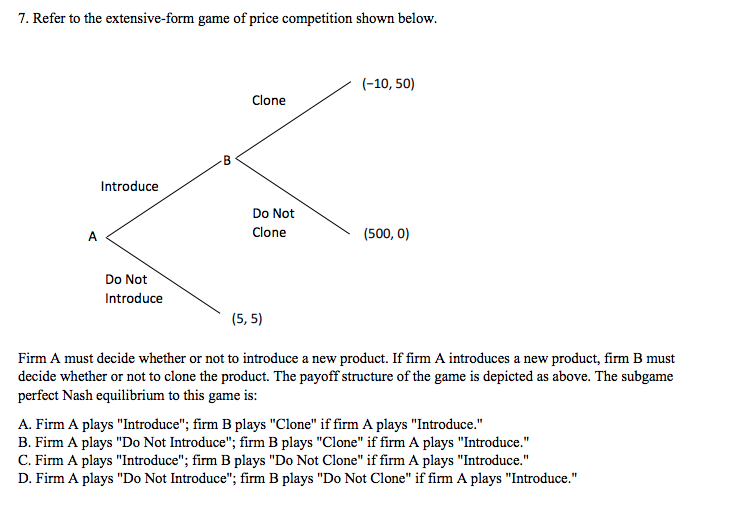Firm A must decide whether or not to introduce a new product. If firm A introduces a new product, firm B must decide whether or not to clone the product. The payoff structure of the game is depicted as above. The subgame perfect Nash equilibrium to this game is: A. Firm A plays "Introduce"; firm B plays "Clone" if firm A plays "Introduce." B. Firm A plays "Do Not Introduce"; firm B plays "Clone" if firm A plays "Introduce." C. Firm A plays "Introduce"; firm B plays "Do Not Clone" if firm A plays "Introduce." D. Firm A plays "Do Not Introduce"; firm B plays "Do Not Clone" if firm A plays "Introduce."
Firm A must decide whether or not to introduce a new product. If firm A introduces a new product, firm B must decide whether or not to clone the product. The payoff structure of the game is depicted as above. The subgame perfect Nash equilibrium to this game is: A. Firm A plays "Introduce"; firm B plays "Clone" if firm A plays "Introduce." B. Firm A plays "Do Not Introduce"; firm B plays "Clone" if firm A plays "Introduce." C. Firm A plays "Introduce"; firm B plays "Do Not Clone" if firm A plays "Introduce." D. Firm A plays "Do Not Introduce"; firm B plays "Do Not Clone" if firm A plays "Introduce."
Chapter15: Imperfect Competition
Section: Chapter Questions
Problem 15.8P
Related questions
Question

Transcribed Image Text:7. Refer to the extensive-form game of price competition shown below.
(-10, 50)
Clone
Introduce
Do Not
A
Clone
(500, 0)
Do Not
Introduce
(5, 5)
Firm A must decide whether or not to introduce a new product. If firm A introduces a new product, firm B must
decide whether or not to clone the product. The payoff structure of the game is depicted as above. The subgame
perfect Nash equilibrium to this game is:
A. Firm A plays "Introduce"; firm B plays "Clone" if firm A plays "Introduce."
B. Firm A plays "Do Not Introduce"; firm B plays "Clone" if firm A plays "Introduce."
C. Firm A plays "Introduce"; firm B plays "Do Not Clone" if firm A plays "Introduce."
D. Firm A plays "Do Not Introduce"; firm B plays "Do Not Clone" if firm A plays "Introduce."
Expert Solution
This question has been solved!
Explore an expertly crafted, step-by-step solution for a thorough understanding of key concepts.
This is a popular solution!
Trending now
This is a popular solution!
Step by step
Solved in 3 steps

Knowledge Booster
Learn more about
Need a deep-dive on the concept behind this application? Look no further. Learn more about this topic, economics and related others by exploring similar questions and additional content below.Recommended textbooks for you


Principles of Microeconomics
Economics
ISBN:
9781305156050
Author:
N. Gregory Mankiw
Publisher:
Cengage Learning

Managerial Economics: A Problem Solving Approach
Economics
ISBN:
9781337106665
Author:
Luke M. Froeb, Brian T. McCann, Michael R. Ward, Mike Shor
Publisher:
Cengage Learning


Principles of Microeconomics
Economics
ISBN:
9781305156050
Author:
N. Gregory Mankiw
Publisher:
Cengage Learning

Managerial Economics: A Problem Solving Approach
Economics
ISBN:
9781337106665
Author:
Luke M. Froeb, Brian T. McCann, Michael R. Ward, Mike Shor
Publisher:
Cengage Learning

Microeconomics: Principles & Policy
Economics
ISBN:
9781337794992
Author:
William J. Baumol, Alan S. Blinder, John L. Solow
Publisher:
Cengage Learning